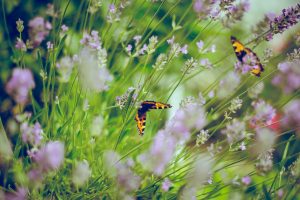We were so happy to welcome arborist James Batton back to our Facebook Group for a live chat about when and how to treat garden pests. Every time we speak with James, we learn so much. He’s a wonderful resource and full of knowledge – especially when it comes to trees and shrubs!
July and August are typically the months during which pests are most active. As an arborist, James Batton is called in to diagnose and recommend treatments for trees. This summer he’s commonly seeing:
- Aphids
- Mites
- Earwigs
- Grasshoppers
About The Garden Pests:
 Mites like it hot and dry – conditions which are par for the course during the summer in Utah. These pests can be difficult to detect – they are about the size of the tip of a needle. If you notice the rich green color of your tree paling, you should check for them.
Mites like it hot and dry – conditions which are par for the course during the summer in Utah. These pests can be difficult to detect – they are about the size of the tip of a needle. If you notice the rich green color of your tree paling, you should check for them.
Testing for mites is simple. Just take a white piece of paper and shake a leaf over it. If you see little dark-colored dots moving around on the paper., you’ve got mites!
How To Treat Mites Quick Tip: Here’s an organic pest control idea. To temporarily get rid of the current population, hose down the tree.
Be on the lookout for aphids too! They’ll often cause a puckering of the tree or shrubs’ leaves. While mites make webs on plants, aphids – which are also larger and easier to spot – drop a sticky substance called honeydew. Honeydew attracts ants for double the pest trouble.
All of the mentioned pests can be treated with pesticides. We recommend going organic, when possible. When using a pesticide to treat any pests, make sure the product you are using is labeled specifically for what you are targeting
When You Should Not Treat Pests
 One thing James Batton was very clear about is that you don’t always need to be in a hurry to treat pests. Especially in the summer.
One thing James Batton was very clear about is that you don’t always need to be in a hurry to treat pests. Especially in the summer.
Why is that? Because the tree is already stressed due to the heat and drought.
Trees in drought stress will absorb what is applied to their leaves to their detriment. Treating a tree that is already stressed with pesticides, fungicides, and even fertilizers can lead to phytotoxicity.
Phytotoxicity is “a delay of seed germination, inhibition of plant growth or any adverse effect on plants caused by specific substances (phytotoxins) or growing conditions.”
While some pest infestations may require immediate treatment, many can wait until temperatures drop.
Some main takeaways from our discussion with James Batton are:
- Keep your tree as healthy as possible. Make sure your trees are getting the water they need to stay healthy. Be sure not to overwater them either. Trees need oxygen just as much as they need water. You can find our Watering Guidelines here.
- The most responsible way to go about pest management is to treat the pests once they show up rather than using preventative chemicals.
- Consider waiting to treat pests. Most leaf pests will not be terminal for the tree. Sometimes treating the tree will be more harmful to its overall health than the pests are.
- Get a proper diagnosis from someone who understands the life cycles of pests, ie. an arborist. They will be able to accurately diagnose the tree and determine whether treatment is immediately necessary.
Take Note Gardeners:
 James Batton is available for landscaping and tree consultations. He’s also teaching classes which we know will be packed full of useful information.
James Batton is available for landscaping and tree consultations. He’s also teaching classes which we know will be packed full of useful information.
- Pruning and Planting
- Landscape 101 (offered for HOA’s, Neighborhoods, and Wards)
- Forest Bathing
- Children’s Classes
- Garden Tours
- How to Survive the Current Drought
If you missed James Batton’s first live with us you can find our notes here. He spoke with us about how trees can help with a waterwise landscape.
Don’t miss out on our next educational Facebook Live, join our Glover Nursery Group today!

